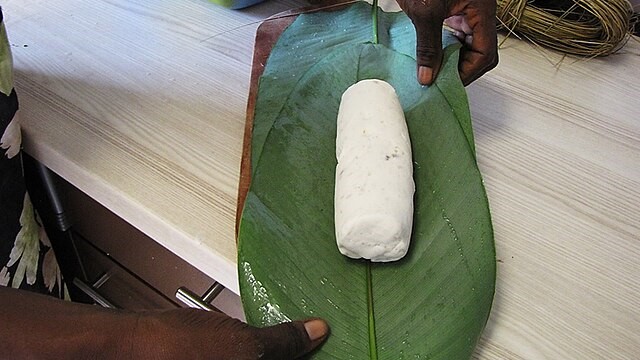In the lush interior of the Democratic Republic of the Congo, where the forest canopy presses close and rivers cut through red earth, the nation’s culinary traditions draw deeply from both the soil and the stories carried by generations. Here, food is more than sustenance; it is a living archive of culture, geography, and history, layered with meaning as much as with flavor.
At the foundation lies cassava, a root that has anchored the Congolese table for centuries. Pounded into fufu—a smooth, starchy accompaniment to stews and sauces—or boiled, baked, or fried, cassava adapts effortlessly to the rhythms of daily cooking. Mild in taste yet rich in texture, it binds together meals that span the spectrum from the purely traditional to the modern kitchen.
From the rainforest, leafy greens play a starring role. Cassava leaves, known locally as saka-saka, and the African eggplant, or plante animal, are simmered or sautéed to accompany thick, aromatic stews. These plants, nutrient-dense and resilient, carry with them the memory of the land, their earthy flavors tied to the heritage of the Congolese countryside.
Few dishes embody the richness of the national palate as completely as moambe, a chicken stew steeped in palm oil and thickened with ground peanuts. The indigenous palm oil, deep red and fragrant, lends the dish both its color and its depth. Served with smoked fish or game, it becomes a celebratory centerpiece, layered with the smoky notes of open-fire cooking and the nutty undertones of the sauce.
Seasonings—ginger, garlic, black pepper—infuse these dishes with heat and complexity, balancing the heft of starches and the richness of oils. Spice blends vary by household, each reflecting the subtle regional distinctions and personal histories of those preparing them.
For centuries, game meats such as wild boar or antelope have been part of the diet, though their place in the modern kitchen is tempered by considerations of sustainability. Where possible, these flavors are recreated with responsibly sourced ingredients, preserving the intensity and aroma of the original dishes while respecting ecological limits.
Modern Congolese cuisine is neither static nor purely preservationist. Chefs and home cooks alike reinterpret the old recipes, merging forest flavors with contemporary techniques, presenting plates that are both anchored in tradition and open to reinvention. In the DRC, the forest remains more than a backdrop—it is the pantry, the spice rack, and the muse, shaping a cuisine that mirrors the land itself: abundant, resilient, and richly storied.
Sources:
- Ngalamulume, K. “Culinary Traditions of the Congo Basin.” African Studies Review, vol. 64, no. 3, 2022.
- Food and Agriculture Organization of the United Nations. “Cassava and Food Security in Central Africa.” 2023.
- UNESCO. “Intangible Cultural Heritage: Traditional Congolese Cuisine.” 2022.


